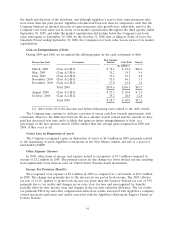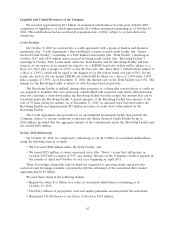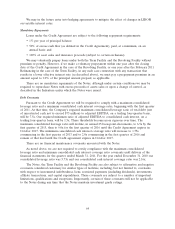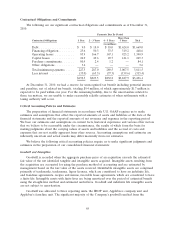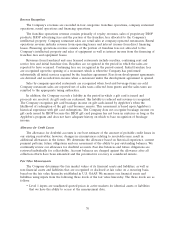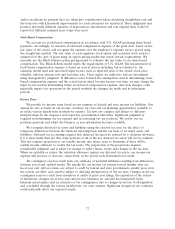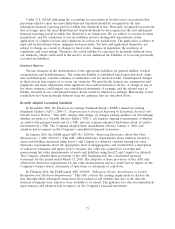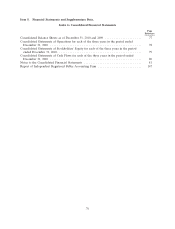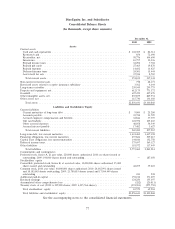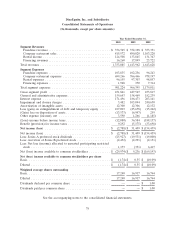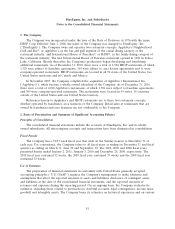IHOP 2010 Annual Report Download - page 87
Download and view the complete annual report
Please find page 87 of the 2010 IHOP annual report below. You can navigate through the pages in the report by either clicking on the pages listed below, or by using the keyword search tool below to find specific information within the annual report.• Level 2 inputs include quoted prices for similar assets and liabilities in active markets, quoted
prices for identical or similar assets or liabilities in markets that are not active, inputs other than
quoted prices that are observable for the asset or liability (i.e., interest rates, yield curves, etc.),
and inputs that are derived principally from or corroborated by observable market data by
correlation or other means (market corroborated inputs).
• Level 3 includes unobservable inputs that reflect our assumptions about the assumptions that
market participants would use in pricing the asset or liability. We develop these inputs based on
the best information available, including our own data.
For more information on the financial instruments the Company measures at fair value, see
Note 11, Fair Value Measurements, of Notes to the Consolidated Financial Statements.
Leases
Our restaurants are located on (i) sites owned by us, (ii) sites leased by us from third parties and
(iii) sites owned or leased by franchisees. At the inception of the lease, each property is evaluated to
determine whether the lease will be accounted for as an operating or capital lease in accordance with
the provisions of U.S. GAAP governing the accounting for leases.
The lease term used for straight-line rent expense is calculated from the date we obtain possession
of the leased premises through the lease termination date. Prior to January 2, 2006, we capitalized rent
expense from possession date through construction completion and reported the related asset in
property and equipment. Capitalized rent was amortized through depreciation and amortization
expense over the estimated useful life of the related assets limited to the lease term. Straight-line rent
recorded during the preopening period (construction completion through restaurant open date) was
recorded as expense. Commencing January 2, 2006, we expense rent from possession date through
restaurant open date. Once a restaurant opens for business, we record straight-line rent over the lease
term plus contingent rent to the extent it exceeded the minimum rent obligation per the lease
agreement. We use a consistent lease term when calculating depreciation of leasehold improvements,
when determining straight-line rent expense and when determining classification of our leases as either
operating or capital.
There is potential for variability in the rent holiday period, which begins on the possession date
and ends on the restaurant open date, during which no cash rent payments are typically due under the
terms of the lease. Factors that may affect the length of the rent holiday period generally relate to
construction related delays. Extension of the rent holiday period due to delays in restaurant opening
will result in greater preopening rent expense recognized during the rent holiday period and lesser
occupancy expense during the rest of the lease term (post-opening).
For leases that contain rent escalations, we record the total rent payable during the lease term, as
determined above, on the straight-line basis over the term of the lease (including the rent holiday
period beginning upon our possession of the premises), and record the difference between the
minimum rents paid and the straight-line rent as a lease obligation. Certain leases contain provisions
that require additional rental payments based upon restaurant sales volume (‘‘contingent rent’’).
Contingent rentals are accrued each period as the liabilities are incurred, in addition to the straight-line
rent expense noted above.
Certain of our lease agreements contain tenant improvement allowances. For purposes of
recognizing incentives, we amortize the incentives over the shorter of the estimated useful life or lease
term. For tenant improvement allowances, we also record a deferred rent liability or an obligation in
our non-current liabilities on the consolidated balance sheets.
Management makes judgments regarding the probable term for each restaurant property lease,
which can impact the classification and accounting for a lease as capital or operating, the rent holiday
71


